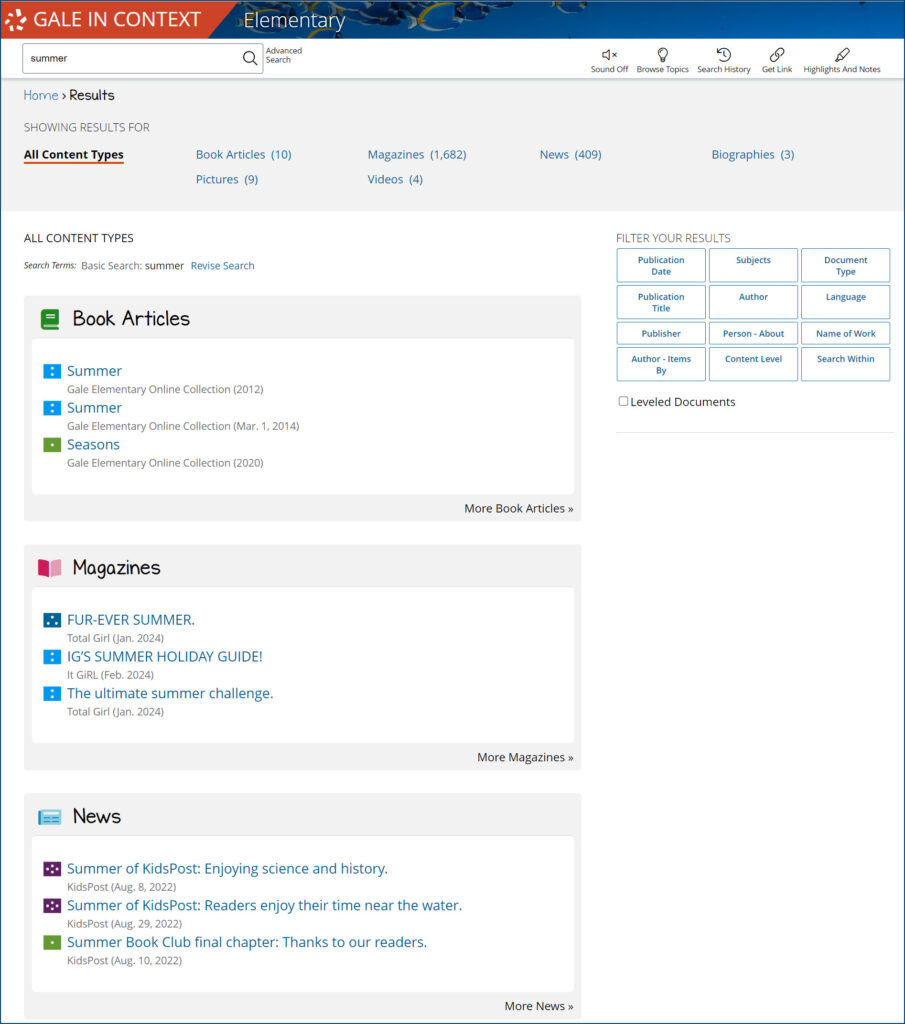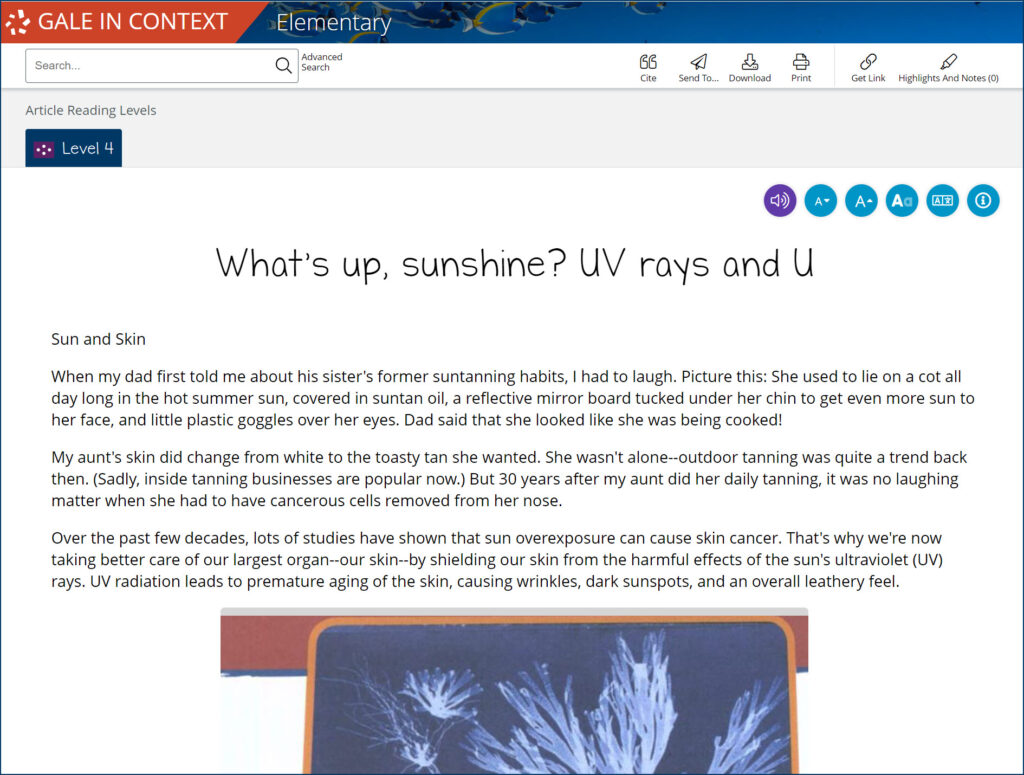| By Gale Staff |
Who doesn’t love summer break? The sun shines, the days are long, and it might even include family vacations or trips to the neighborhood pool. While undeniably magical months, how much do your young learners know about the changing seasons? What about why schools close for the summer? And what about other parts of the world? Do they observe summer break?
In 2024, summer officially begins on June 20—otherwise known as the summer solstice. In preparation, send students off with a fun summer-themed lesson plan. Gale In Context: Elementary has thousands of related resources, including videos, podcasts, magazine articles, and relevant news stories. Plus, Elementary always presents research materials in an accessible format, including platform tools that engage all students regardless of reading level or individual needs.
Gale In Context: Elementary makes your life a little easier, too. The database does the heavy lifting for you, presenting an age-appropriate research collection and even housing ready-made activities for early learners. Get summertime started for everyone with a little help from Gale.
Explore How the Sun Sustains the Earth
Nothing says summertime like sunshine. But if you think it’s hot here on Earth, imagine what it’s like closer to the center of our solar system! The sun is 27 million degrees Fahrenheit at its core—hot enough that you can still get a sunburn from 92 million miles away!
At 865,000 miles in diameter, you could fit almost one million planet Earths inside the sun. While this may seem huge to us, it’s a surprisingly average-sized star within the cosmos. But for life on Earth, it’s just the right size. Our solar system’s shining star is the foundation for life on Earth, as sunlight is vital to growing food and keeping the planet warm.
Ask your students why the weather is so sunny during summertime. Introduce the astronomical concept of the Earth’s orbit around the sun and how its orientation (the axis) determines changing seasons. It’s an abstract idea and may be difficult for elementary learners to grasp. You can find helpful videos and graphics in Gale In Context: Elementary to accommodate your classroom’s different learning styles.
Activity Idea: Understanding astronomy can be a challenge. After all, it’s not like your students can feel the Earth spinning around the sun. However, we can observe the changing seasons around us. Take your class outside or to a nearby park for a nature walk. Encourage them to notice how certain plants grow toward the sun and ask them to consider why shadows change throughout the day. Why does the sun move across the sky? What time does the sun set at night compared to winter months? These small observations help young learners engage with the complexities of the summer solstice in a practical way.
Learn the Why Behind Summer Break
Besides giving everyone (teachers included) a much-needed respite, why do U.S. schools observe summer break? Ask your students to brainstorm and share their ideas.
While several possible reasons exist, there is one primary explanation—the heat. Historically, before a systemized school calendar, many institutions would close over summer break. During summer, wealthy families were more likely to leave cities to enjoy the cooler climates in the country. So, when it came time to codify national school standards, it made sense to maintain that schedule.
Today, summer break is a valuable time for teachers to train and prepare for the next school year. However, some school districts have a short summer break with more days off throughout the year, while others prioritize a long three-month vacation. Take a poll: Which option would your class prefer?
Discussion Idea: With the extra time away from school, summer is an opportunity to relax—and to think about trying out new things. Encourage students to create a summer goal. Maybe they’d like to try a new sport. Or perhaps they’d like to read at least five new books or make a friend at camp. No matter the objective, working toward a goal can help them build confidence for the next school year.
Discuss Summertime Around the World
The summer solstice in the Northern Hemisphere occurs on June 20 or June 21, and most U.S. schools close for summer break around that time. But how do other countries observe their school year? Do students elsewhere enjoy summer break?
In France, students enjoy a two-month summer break from July through August. Many French adults take vacation for the entire month of August, as well! Most European schools average a summer break of six to eight weeks, and families tend to go on vacation or enroll students in summer camps.
In China, where summer vacation lasts around two months, students are more likely to attend summer school programs or vocational training. In South Korea, students have a brief month-long summer break in August, and many students spend their time off at the pool or the beach. No matter where they’re from, all kids tend to have the same summertime desire: to head outside and play!
Discussion Idea: Ask students how they plan to spend their summer break. What are they most looking forward to? From ice cream trucks to swim lessons to sleepovers, there are many ways to spend the summer months.
Practice Summer Safety
Before letting students leave for summer break, be sure to touch on summer safety tips. Wear a helmet for biking around the neighborhood. Always secure your life vest when on the water. Listen to the lifeguard at the pool. And, of course, wear sunscreen!
Our sun emits ultraviolet (UV) radiation, and because the Earth’s Northern Hemisphere tilts toward the sun in summer, UV rays are strongest during those months. Even on cloudy days, people risk sunburns and sun damage during the summer. Young students have more sensitive skin and are likely to spend more time outdoors, so help them build healthy sun protection habits.
Activity Idea: Make a summer safety poster. As a class, write a list of safety tips on one large poster. Encourage students to sign the poster as a promise to follow this shared classroom commitment.
With the summer solstice approaching, it’s time to create a great summer-themed lesson plan for your students. You can rely on Gale’s databases to welcome the changing seasons and slide into a relaxing summer break.
If your school is not a Gale subscriber, contact your local representative to learn more about Gale In Context: Elementary!



